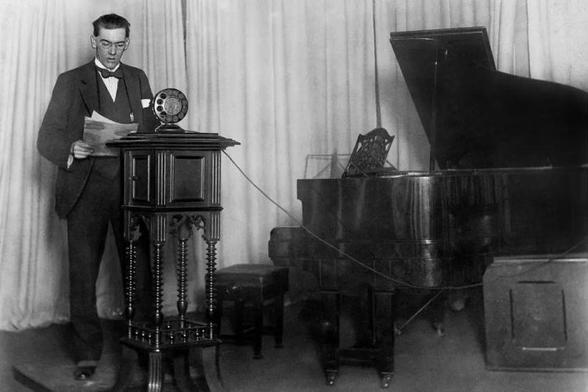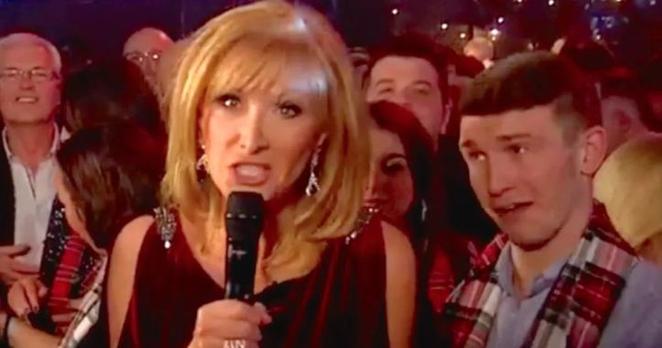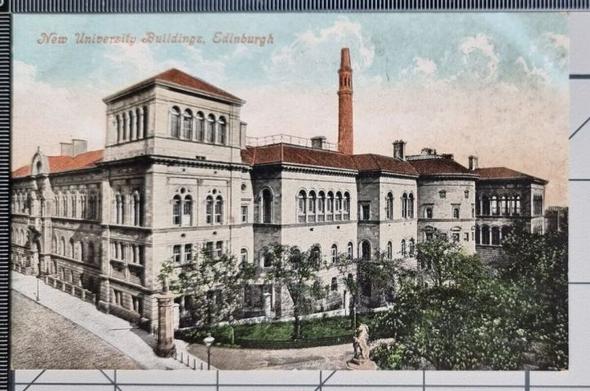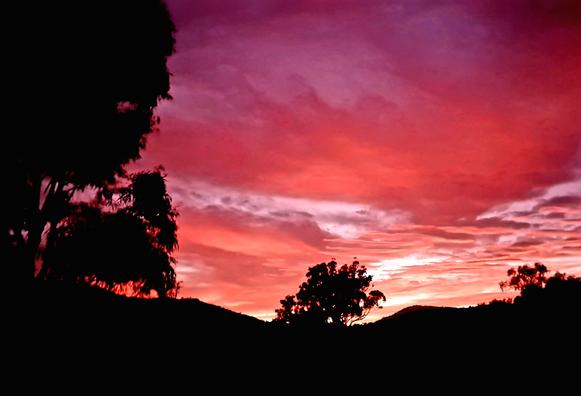The thread about the dawn of BBC radio in Edinburgh and the centenary of the first Scottish Hogmanay programming
A fact that passed me by until this morning (January 1st, 2025); yesterday marked the 100th anniversary (in Edinburgh at least) of the tradition of special Hogmanay programming from BBC Scotland. I think the fact possibly also passed the Beeb by too, even though they were very aware of celebrating the centenary of the general launch in 2023… So follow me now on a brief thread that explores the early history of BBC Radio in the capital and the city’s claim to being the home of the now ubiquitous annual Hogmanay broadcasting extravaganza.
Jackie Bird, presenting yet another BBC Scotland Hogmanay special.
The BBC’s first and principal Scottish transmitter was named 5SC, was based in Glasgow and started transmission in March 1923. It had a power of 1.5kw and a notional range of 75 miles; but only if you had the right sort of valve wireless set at home; in Edinburgh, 75% of homes with sets didn’t, they used cheaper, crystal sets. This fact allied with the wavelengths used and Edinburgh’s particular topography meant that the BBC was largely unreceivable across the capital.
Herbert Carruthers, director of the BBC’s first radio station in Scotland.
To make up for 5SC‘s lack of coverage the BBC planned small repeater stations for the main cities in Scotland. Aberdeen got 2BD in October 1923 and the following year Edinburgh would get 2EH in May and Dundee 2DE in November. However, broadcasting from a transmitter within Edinburgh posed the early radio engineers a pair of unique geographical problems. Firstly, at the wavelengths the station operated at (328m), the city’s hills were a challenge to get the signal to go either around or over, leaving a shadow of no or poor reception behind them. Secondly it proved very difficult to properly earth the transmitter owing to the geology beneath the city centre. As a result, even at just 2 miles distance from 2EH, it required home users to fit a 100ft long outdoor aerial to pick up the signal on the prevalant crystal receiver sets and the City Corporation were reluctant to permit antennae to be strung across the streets between tenements.
After searching for the best possible broadcast spot the men from the BBC installed the technological marvel of 2EH‘s transmitter equipment in a wooden shed behind the University’s medical school at Teviot Place, the 150 foot (46m) aerial strung from the chimney stack. The studio and control room was at 79 George Street initially.
The Edinburgh University “New Buildings” medical school on Teviot Place
2EH was commissioned on May Day 1924 with a special live broadcast and concert from the Usher Hall. It commenced at 730PM with the callsign “2EH Calling. 2EH Calling” being the first words heard by any listeners. Music was provided by the band of the King’s Own Scottish Borderers and an organ recital was played by Dr W. B. Ross. Speeches began at 9PM when the Lord Provost, Sir William Lowrie Sleigh, officially announced the opening, followed by a speech by J. C. W. (later Lord) Reith. After 10 more minutes of military piping at 930 the relay from London was plugged in and “2LO Calling” (London’s callsign) was announced to the listening public in Edinburgh – which probably amounted to no more than 800 at this time. 2EH then took over again and Mr G. K. Marshall, station director, read the local news from George St., bringing the small audience of lucky listeners an update on a fire in South Bridge and “other interesting intelligence” such as the escape of the Zoo’s sealions. The evening then settled down to the London broadcast of the opera Faust.
Edinburgh Evening News, headline, May 2nd 1924
2EH‘s main job was as a broadcast relay for 2LO in London and Scottish content from 5SC in Glasgow, but it did put out a small volume of local programming and outside broadcasts from its tiny 20sq ft studio on George Street. These premises were rented from Townsend & Thomson’s music shop and proved totally inadequate (the “offices” were merely a through corridor, the studio the proprietor’s living room) so they were soon moved to more commodious and efficient space along the road at 87 George Street. The transmitter also proved rather hopeless and complaints were numerous in the Evening News and so it too was soon replaced. In October 1924, the BBC sent up the now surplus transmitter it had installed to broadcast live from that summer’s British Empire Exhibition at Wembley Stadium.
2EH Control Room, 79 George Street, Edinburgh”. From “The BBC in Scotland : the first 50 years : a personal memoir” by David Pat Walker, 2011
A heavy rivalry existed between 2EH and its nominal parent at 5SC in Glasgow and as a result listeners in Edinburgh were treated to more than their fair share of relayed content from 2LO in London instead.
The BBC 2LO transmitter on Marconi House on the Strand. Credit, BBC100 website.
This brings us to Hogmanay broadcasting. Listeners in the reception range of 5SC in Glasgow were treated to some of Scotland’s first BBC Hogmanay programming in 1923, but it was a basic schedule from 5PM onwards, with a mixed content (although interestingly it included some Gaelic language singing) and handed over to London at 10PM for the rest of the night.
Daily Record, 31st December 1923, “Wireless Programmes, Glasgow 5SC”.
Most listeners in Edinburgh would have to wait a whole other year for the privilege of allowing Auntie into their living rooms and 2EH pulled out the stops to put on its own, special Hogmanay show for them. There were something like ten to twenty thousand wireless licenses issued by the Post Office in Edinburgh at this time, giving you an idea of the potential audience. Highlighting the rivalry with 5SC in the west, the Evening News reported that station’s schedule as a passive aggressive footnote under 2EH subtitled “Glasgow Fare“.
Edinburgh Evening News, 31st December 1924, “Radio To-Day – Local Hogmanay Programme” – Station 2EH (Edin.); 328 metrers”, and an itemised listing of the broadcast schedule below.”
So if you’d strung your 100ft wireless antennae, got the crystals warmed up, pulled up your armchair and tuned in on Hogmanay 1924, what would you have heard?
Grampa Simpsons enjoying his wireless
The show began at 3PM with an hour of piano music live from George Street, followed by an hour’s intermission and then an hour of children’s programmes. The stories, half of which were specifically Scottish, told by “Uncle Leslie” and “Auntie Mollie” (an early example of the anthropomorphising of the BBC into a benevolent relative in the wooden box in the corner of the room?) After another intermission, at 7PM the bells of Big Ben were broadcast from London (I believe SB in the schedules stands for syndicated broadcast), followed by a weather forecast and news bulletin. Mr C. H. B. Quennell then gave a lecture from London to fill up the rest of the half hour slot on “Every Day Life in Stuart and Georgian Times“. With everyone warmed up by that, at 730PM the Hogmanay “Scottish Night” special started proper, with the pipers of the 4/5th Battalion, The Royal Scots, introduced by announcer Miss Rosaline Masson, a well known local novelist. The pipers, a vocal octet and varous other musicians then took turns playing and singing a programme of largely traditional Scots music until the 930PM news and weather from London. The heavy part that a variety of Trad music has to play in the BBC’s Hogmanay scheduling is something that continues to this day.
Auntie in London then got folk really in the mood for the biggest night of the year with a 30 minute lecture on Horticulture by Mr J. S. Chisolm before everyone must have breathed a collective sigh of relief and woken up from their snoozes as the switch was once again thrown back to Edinburgh. More popular music now followed when a live outside broadcast was switched on from the Palais de Dance at Fountainbridge and The Romany Revellers band, “Scotland’s Finest Dance Band” and a regular at the establishment which could lay claim to being Scotland’s premier night spot at this time. This must have been quite a revolutionary event at the time. Music, live from a dance hall! Again, the incorporation of popular contemporary music and artists remains in the BBC’s Hogmanay template to this day, as does the “lounge” studio atmosphere with guests drawn from members of the public arrayed at table and chairs. One key difference was however that the Palais was a dry venue at this time and the strongest drink served by its cocktail bar was fruit juice!
Interior of the Palais de Danse dance-hall at Fountainbridge. A basket of balloons can be seen suspended from the ceiling, ready to drop. The curved edge of the stage is visible on the left. Credit, The City of Edinburgh Council Museums & Galleries
With just 15 minutes until the bells, the party in full swing and fever pitch building to a crescendo, the broadcast switch was thrown once again. This time it took the home listeners to St. Columba’s Church of Scotland in London for a blessing from the Rev. Archibald Fleming followed by the hymn “Praise God from Whom All Blessings Flow“. Just before midnight, that great tradition of Auld Lang Syne being sung was broadcast from St. Columba’s followed by the bells of Big Ben one final time and the message “A Happy New Year to All” crackled over the airwaves from London. Finally the plugboard was rewired one last time in George Street and the “Romany Revellers” returned to the wireless sets of Edinburgh live from the Palais for a final hour of the latest hits.
St Columba’s Church of Scotland, Pont St, London. Photograph, PD, credit Matthew Ross via Wikipedia.
That is except, to paraphrase the old Scottish joke about BBC programming, except for listeners in Glasgow. Listeners of 5SC got no such local treat that year, from 930PM they only got the London broadcast, with music from the Savoy Hotel Orpheans and Havana bands, and come midnight the plug was pulled and it closed down just after midnight after the Rev. Fleming’s and Big Ben’s chimes. I’m sure readers from the west will be quick to point out that Glaswegians did not need the BBC on the wireless to keep the music and the party going after midnight! But on this basis, Edinburgh has a pretty strong claim for producing the first full BBC Scotland Hogmanay show 100 years ago, and in a format we would largely recognise today. And the rest, as they say, is, history and various artists have been butchering Auld Lang Syne just before the bells, every year hither!
“No Marty, No Party”, according to the announcer; Marty Pellow sings “With A Little Help From My Friends” on the BBC Scotland Hogmanay Show 2024/25. For the record, he did not turn his talents to “Auld Lang Syne” this year.
For a fuller history of the 2EH Edinburgh station of the BBC, please head on over to the excellent page on the subject at Scotland on Air.
If you have found this useful, informative or amusing, perhaps you would like to help contribute towards the running costs of this site (including keeping it ad-free and my book-buying budget) by supporting me on ko-fi. Or please do just share this post on social media or amongst friends.
These threads © 2017-2025, Andy Arthur
#BBC #DanceHalls #December31 #Entertainment #GeorgeStreet #Hogmanay #January1 #Radio #Written2025





